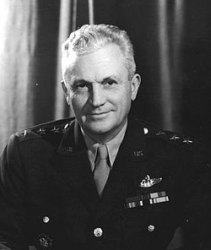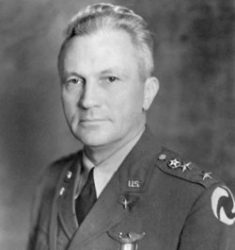
 |
|
|
||
|
Frank Maxwell Andrews 'Andy' |
||||
|
Engagements: • World War II (1941 - 1945) |
||||
| Biography: | ||||
|
Frank Maxwell Andrews Frank Maxwell Andrews was born in Nashville, TN, the grandson of a cavalry soldier who fought alongside Nathan Bedford Forrest and the great-great-nephew of two Tennessee governors, John C. Brown and Neill S. Brown (Nashville Banner, 5 May 1943). He graduated from Nashville's Montgomery Bell Academy in 1901. Military Life Andrews entered the U.S. Military Academy in July 1902 and graduated 42nd in his class on 12 June 1906. On that date he was also commissioned a Second Lieutenant in the 8th Cavalry. He was assigned to the Philippines from October 1906 to May 1907, and then to Fort Huachuca, AZ. In 1912 he was promoted to an available billet as a First Lieutenant in the 2nd Cavalry, at Fort Bliss, TX, and in 1916 received a promotion to Captain in the regiment while at Plattsburgh Barracks, NY. The U.S. Army he joined was smaller than that of Bulgaria, but it gave the young Second Lieutenant ample opportunities to play polo, see the world (serving as aide-de-camp to Gen. M.M. Macomb in the Hawaii between 1911 and 1913), and observe the high and low politics of leadership. After marrying Josephine "Johnny" Allen, the high-spirited daughter of Maj. Gen. Henry Tureman Allen, in 1914, Andrews gained entrée into elite inner circles of Washington society and within the military. A story related in the press many times during Andrews' lifetime claimed that Gen. Allen forestalled the aeronautical aspirations of his future son-in-law by declaring that no daughter of his would marry a flyer. Andrews' service records, however, show that his commanding officer in the Second Cavalry vetoed his application for temporary aeronautical duty with the Army Signal Corps in February 1914, a decision that held firm despite a plea from the Chief Signal Officer's for reconsideration by higher-ups. After the U.S. entered World War I, on 5 August 1917 Andrews was promoted to the temporary rank of Major and assigned, over the objections of his cavalry commander, to the Aviation Section, U.S. Signal Corps as part of its wartime expansion. After staff duty in the Office of the Chief Signal Officer in Washington, DC, between 26 September 1917 and 25 April 1918, Andrews went to Rockwell Field, CA, for flying training. There, he earned a rating of Junior Military Aviator at the age of 34. As with nearly all mid-career officers detailed to the Aviation Section, Andrews did not serve in France but as an administrator in the huge training establishment created to provide pilots. He commanded various training airfields in Texas and Florida, and served in the War Plans Division of the Army General Staff in Washington. Following WWI, he replaced Brig. Gen. Billy Mitchell as Air Officer of the Army of Occupation in Germany, which his father-in-law, Gen. Allen, commanded. While in Germany, Andrews received his permanent establishment promotion to Major, Cavalry, when the National Defense Act of 1920 took effect on 1 July. He then transferred, in grade, to the Air Service, which the Act had made a combat arm of the Army on 6 August. Air Service & Air Corps Duty After returning to the U.S. in 1923, Andrews again assumed command of Kelly Field, TX, and he became the first Commandant of the Advanced Flying School established there. In 1927, he attended the Air Corps Tactical School at Langley Field, VA, and the following year he went to the Army Command and General Staff School at Fort Leavenworth, KS. Promoted to Lieutenant Colonel, Andrews served as Chief of the Army Air Corps' Training and Operations Division in 1930-1931, before being replaced by the new Chief of the Air Corps, Maj. Gen. Benjamin D. Foulois. He then commanded the 1st Pursuit Group at Selfridge Field, MI. After graduation from the Army War College in 1933, Andrews returned to the General Staff in 1934. In March 1935, Army Chief of Staff Douglas MacArthur appointed Andrews to command the newly-formed General Headquarters (GHQ) Air Force, which consolidated all the Army Air Corps' tactical units under a single commander. The Army promoted Andrews to Brigadier General (temporary) and then, less than a year later, to Major General (temporary). A vocal proponent of the four-engine heavy bomber in general, and the B-17 Flying Fortress in particular, General Andrews advocated the purchase of the B-17 in large numbers as the Army's standard bomber. MacArthur, however, was replaced as Chief of Staff by Gen. Malin Craig in October 1935. Craig, who opposed any mission for the Air Corps except that of supporting ground forces, and the Army General Staff, actively opposing a movement for a separate air force, disagreed with Andrews that the B-17 had proven its superiority as a bomber over all other types. Instead, it cut back on planned purchases of B-17s to procure smaller but cheaper (and inferior) twin-engine light and medium bombers such as the Douglas B-18. However, the war in Europe would soon prove the advocates of long range air power correct. Following the death of Maj. Gen. Oscar Westover in September 1938, Andrews was passed over for appointment as Chief of the Air Corps, partly because of his aggressive support for strategic bombing. He became a trusted air adviser to George C. Marshall, newly appointed as Deputy Chief of Staff of the Army in 1938, but more senior authorities felt that Andrews pushed too hard. After President Franklin D. Roosevelt had publicly called for a large expansion of the Air Corps in January 1939, Andrews described the United States as a "sixth-rate air power" at a speech to the National Aeronautic Association, antagonizing isolationist Secretary of War Harry Woodring, who was then assuring the public of U.S. air strength. At the end of Andrews’ four-year term as Commanding General of GHQAF on 1 March, he was not reappointed. He reverted to his permanent rank of Colonel and was reassigned as Air Officer for the Eighth Corps Area in San Antonio, TX, the same exile to which Billy Mitchell had been sent. Possibly expected to retire, just four months later he was instead recalled to Washington by Marshall after President Roosevelt named Marshall to serve as Chief of Staff following Craig's retirement. Marshall's choice of Andrews as his first senior staff selection, with its permanent promotion to Brigadier General, prompted furious opposition from Woodring and others. However, Marshall prevailed after threatening to resign his new post. As Assistant Chief of Staff for Operations (G-3), he was in charge of readying the entire Army in the run-up to America’s inevitable involvement in the war. World War II In 1940, Andrews assumed control of the Air Corps' Panama Canal Air Force, and in 1941, he became Commander of the Caribbean Defense Command, which had the critically important duty during World War II of defending the southern approaches to the United States, including the vital Panama Canal. In February 1942, General Andrews was in Aruba and witnessed the German submarine attack on the island. That same year he went to North Africa, where he spent three months in command of all U.S. forces in the Middle East from a base in Cairo, Egypt. At the Casablanca Conference in January 1943, Lieut. Gen. Andrews was appointed Commander of all U.S. forces in the European Theater of Operations, replacing Dwight D. Eisenhower. In his memoirs, Gen. Henry H. Arnold, Commander of the Army Air Forces in World War II, expressed the belief that Andrews would have been given the command of the Allied invasion of Europe — the position that eventually went to Gen. Eisenhower. Gen. Marshall would say, late in life, that Andrews was the only general he had a chance to groom for a possible Supreme Allied Command later in the war. However, during an inspection tour on 3 May 1943, Lieut. Gen. Andrews was killed in the crash of B-24D-1-CO Liberator, 41-23728, of the 8th Air Force out of RAF Bovingdon, England, on Mt. Fagradalsfjall on the Reykjanes Peninsula after an aborted attempt to land at the Royal Air Force station at Kaldadarnes, Iceland. Andrews and thirteen others died in the crash; only the tail gunner, S/Sgt. George A. Eisel of Columbus, OH, survived. Badge & Medals Command Pilot Badge Honors Joint Base Andrews, located a few miles southeast of Washington, DC, and the home base of Air Force One, is named in honor of Andrews. A Royal Air Force airfield called RAF Station Great Saling, was renamed Andrews Field after him, in Essex England. It was the first airfield constructed in 1943 by Army engineers in the United Kingdom during World War II. It was notable as having been the only renamed US airfield in the United Kingdom during World War II. It was used by the USAAF 96th Bombardment Group (Heavy) and the 322nd Bombardment Group (Medium) during the war, and also by several RAF squadrons before being closed in 1946. Today, a small part of the former wartime airfield is still in use as a small private flying facility. Andrews Avenue, a road leading to the Philippines' Ninoy Aquino International Airport Terminal 3 was named after him. Burial Lieutenant General Frank Maxwell Andrews is buried at Arlington National Cemetery in Arlington, VA. |
||||
| Honoree ID: 2069 | Created by: MHOH | |||
Ribbons
Medals
Badges
Honoree Photos
 |  |  |
 |  |
 |


